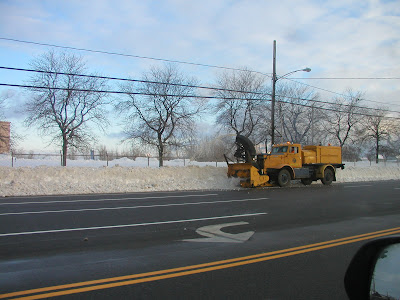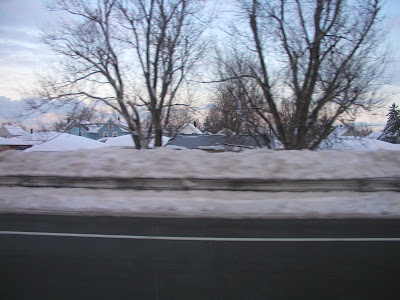The first post in this two-parter was about fighting my way through traffic to get into New York City. This installment is about the joys and vistas of the journey home.
In addition to the deserted early morning roads and uninterrupted NPR programming, other things I really like about these NYC trips include the great variety of things there are to see across the dashboard and the chance to change up the route and explore on the way home.
You get a little taste of the Manhattan views on the way into the Lincoln Tunnel (see
post #4) but there are really spectacular city vistas (one kind of view) can be had on the way home too.
As part of that "take a different route home" thing, instead of going back through the Lincoln Tunnel, I sometimes head over to the West Side Highway. One of the first things you see once you are driving north from mid-town is the
Intrepid Sea, Air & Space Museum, which is housed on the retired WWII aircraft carrier
USS Intrepid.
It's pretty eye catching; not the kind of thing you expect to see as you drive along most roads. It is a gigantic ship, but it is actually amazing how small it looks, given what it was used for. They landed
airplanes on this thing!
 |
| USS Intrepid, obviously. |
But if you grew up like me, obsessed with airplanes, reading books like
Jane's Book Of Aircraft and
Air War Against Hitler's Germany (The American Heritage Junior Library Edition. Just re-read it a last year...) the thing that puts your head on a swivel and really grabs your attention are those angled-in tail fins of the plane to the right.
 |
Lockheed SR-71 Blackbird in profile. I actually turned around and headed back
down the West Side Highway to take this. Conveniently, there is a legal u-turn just north of the ship
and a stop light at the Museum entrance. I got lucky and caught a red light in the perfect spot. |
The SR-71 has held or holds virtually every record for manned non-space flight including altitude (85,069 feet) and speed (Mach 3.32, 2193mph). Only 32 Blackbirds were ever built. With the coming of the satellite era, the need for a spy plane that can fly over any spot in the world to take pictures of it in just a few hours has disappeared. The Blackbird was retired in 1998.
It still looks (
more pictures) like something out of the future, which I find very encouraging as the SR-71 and I were introduced to the world in the same year (
1964).
The West Side Highway also has great views of the Hudson River and one of New York's other great iconic structures, The
George Washington Bridge.
 |
The Hudson River with the GWB in the background.
Aesthetically, both would benefit greatly from the addition of a big monkey. |
 |
Just about to head under the first tower of the GWB.
This would be an excellent place to put the monkey. |
Sometimes when leaving the city via the GWB, I'll take the first right and head up the
Palisades Parkway. If I had done that on this trip, I'd have some (hopefully) great pictures of upper Manhattan, Bear Mountain and the Hudson River. Another trip perhaps.
This time I continued west through New Jersey on Route 80. So, with apologies to New Jersey, it was a while before I felt compelled to pull out the camera to document the other kinds of vistas on offer during the trip home.
The drive west on route 80 offers some fantastic views of rural New Jersey, especially as you approach the
Delaware Water Gap. The Delaware River is the
longest un-dammed river east of the Mississippi and provides drainage for nearly 14,000 square mile of New York, New Jersey and Pennsylvania. All of the water from New York and western/northern Pennsylvania that drains into the Delaware flows through the gap.
 |
The Delaware water gap is a break in what is the first (or last, depending
on your point of view) major ridge of the Appalachian Mountains. |
The break in the ridge can be seen for miles from both the eastern and western approach. The landscape is pretty dramatic as you enter the gap.
 |
| Exposed rock ridge line of Mt. Tammany on the northern side of the gap. |
 |
| Exposed rock ridge line of Mt. Minsi on the southern side of the gap. |
 |
| Boulder field just below the upper ridge. It comes right up to the roadway. |
The gap also marks the southern entrance to the
Delaware Water Gap National Recreation Area, which is an area I highly recommend you take some time to explore, if you are ever in the area. It's even worth a trip of its own with both great river access for boating or swimming and hiking at a variety of levels.
It also a great jumping-off-point for that other thing I like about theses drives; a little exploring! If you get off route 80 at the park entrance (there is no fee), you can not only stop in at the visitors center or one of the other buildings that cater to, uhm, visitor needs, but also get on the first of a series of small 2 lane roads that take you
north along the river.
 |
Leaving the visitor's center headed north on Old Mine Road (closed in winter).
That's route 80 on the Bridge above, just before the toll booths that are on the Pennsylvania side. |
 |
| National Park Service road 615 (Walpack-Flatbrook Road), just south of Walpack Center. |
The views and vistas of these isolated roads are fantastic as they work their way north through the park on alternating sides of the stream valley. It takes you past some great park facilities (hiking, swimming, education centers) and through little hamlets of buildings, some run as historic sites by the park service, and other like the
Peters Valley Craft Center that just seem to pop up out of nowhere.
But the real highlight of this route comes when you finally have a chance to cross the Delaware River into Pennsylvania.
Dingmans Ferry is the spot. It has been a crossing point on the Delaware since at least 1735 when Andrew Dingman began running a flat boat ferry across this narrow, calm portion of the river. It is the only access to or from New Jersey for 30 miles to the south and at least 15 miles to the north.
Of course, there is no ferry at Dingmans Ferry anymore. The location has been the home to a series of bridges beginning in 1836 (although Andrew Dingman III, after a series of bridge failures, ran a ferry here for about 40 years until the turn of the 20th century). The current bridge was built in 1900 and has been in constant use since November of that year.
 |
Dingmans Ferry Bridge, very full of traffic!
I don't think I'd put a big monkey on it, despite the 4 ton sign. |
There are 3 very cool things about the bridge.
First, it has a wooden deck. Actually, that alone would be enough to make it cool! When was the last time you drove on a wooden deck bridge, especially one this long that actually sees significant traffic?
 |
| Yep! Those are wooden planks! |
Second, it is one of the last privately owned (don't worry, they are subject to all the safety regs) bridges in the US. Take a minute to think about that. A bridge, connecting two states and two public roads, owned by a family run private firm. Imagine this conversation at elementary school career exploration day.
"So Jenny, what are you going to be when you grow up?"
"When I'm a grown up, I'm going to run my family's bridge!"
"What?"
"Our Bridge. The one over the river with all the cars and stuff. I'm going to run it and take the money and fix the planks and paint the cables and make sure no trucks that are too big ever get on it! And I'll let bikes and school buses and ambulances and all my bestest friends go over for free!"
"That's nice dear"
Later in the staff room:
"Poor Jenny, she thinks her Mom & Dad who work in the toll booth actually OWN the bridge. So Sad..."
Last Laugh to Jenny!
The third super cool thing about the bridge is the toll taker.
 |
| Toll taker, on the Pennsylvania side, Dingmans Ferry Bridge. |
That's right. My man is STANDING. In the middle of the road. He is standing ALL day and night. He is standing all day and night taking $1.00 from everyone coming or going over the bridge and putting it in a bucket. He is not in a booth; doesn't WANT a booth; doesn't even KNOW what a booth is. He is resolute and immovable; respecting, directing, protecting and collecting from all those who want to abandon or gain the Pennsylvania shore.
OK, so maybe I'm being a little overly dramatic but damn, can we get my man a chair? I mean the bridge is open 24/7/365.
He does get one day a year off. The bridge is free on Christmas (and always for bikes, ambulances and school buses, just like little Jenny said). I may drive down on December 25th just to take advantage of that, as a little gift to myself.
(And yes, I realize there must be more than one toll taker......better story my way)
From this fabulous bridge, the drive takes you up Route 739, also known as Dingmans Turnpike, through the town of Dingmans Ferry and more beautiful scenery, finally leading back to the big highway Route 84. Which I reluctantly get on. Because, after all, I really do need to get home.



















































